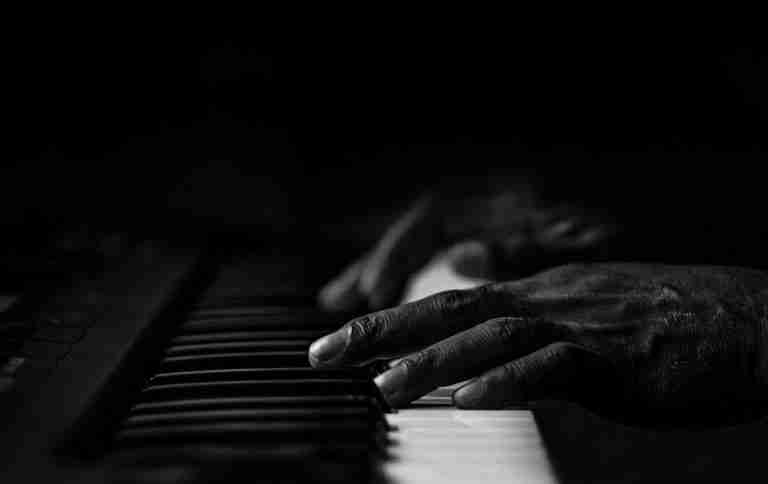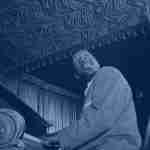A reader recently wrote: “I was reading your “6 mistakes” article and was intrigued by the first rule. I would be more than happy to toss my lousy sixth edition real book, but have some questions about learning tunes by ear. When I’m blowing through changes or learning licks, it all comes down to the chords. So I depend on the changes in the book. On recordings, a lot of the time all I can hear is the linear solo, and can’t hear the changes in the rhythm section. So when I learn a standard by ear, how should I approach figuring out the changes?”
This is a great question and one that I’ve often struggled with myself. Sure, it’s simple enough to get the melody from a record without looking at a book, but deciphering all the chord changes can be another story. Whether it’s because of a poorly recorded track, a fast tempo, or just flat-out inexperience, taking the time to figure out each chord to a standard can be frustrating.
So why not look up the changes in a real book?
A chart in the real book represents just one version of a tune taken from one recording. That chart may have been based on substituted chord changes, a different key, or even an embellished melody. You have no way of knowing unless you check out the record for yourself. Many times, I have learned a tune from a book only to realize too late that it’s normally played in a different key. Before you learn a tune, make sure you are getting the definitive progression by checking out numerous recordings.
It’s also important to note that just because the melody and chord progression are printed in the real book, doesn’t mean that they’re correct. I remember Mulgrew Mulgrew giving an example about his own experience in learning tunes from a book. As a young musician, Mulgrew said that he had learned the tune Four from his real book. Some time later he was playing the tune again, this time as a sideman to a well know saxophonist.
After the set, the leader brought him aside and informed him that he was consistently playing an incorrect chord throughout the tune. Surprised, he went back to the recording and found that sure enough, he had learned that wrong chord from the real book. By actually hearing the progression instead of reading it, the correct chord became painfully obvious. Mulgrew stressed that the answers are all there in the recording, you just have to have the drive to get them.
Start to improve your ears
Aside from a lack of variety and errors, the main reason to toss the real book is to develop the ability to figure out chord progressions by ear. Having this skill is necessary to actually navigating chord progressions in a logical and creative way. As you improve, you’ll be able to hear chord progressions go by and know the quality and function of each chord aurally.
Conversely, by memorizing the changes from a real book, you’re visually inputting each chord. As you go to improvise you’ll be restricted to thinking only of chord names (C, Ab7, D-9, G7, etc.) rather than the unique sound of each chord. Essentially, turning improvising from an intuitive musical activity into a limited mental exercise. Remember that your focus should always be on the sound of the chords, not on memorizing chord symbols.
Here are a few techniques that have helped me to figure out chord progressions…
Find as many versions of a standard as you can
The great thing about being a jazz musician in the information age, is having access to nearly every standard at your fingertips. Go to youtube and type in the name of a standard and see how many versions come up. This is a invaluable resource in learning standards. Not only do you have access to hundreds of tunes, but also multiple versions and instrumentation of each tune. To make sure you are getting the correct progression, compare as many versions as you can.
When you are learning a tune for the first time though, be sure to look for the clearest and simplest version. Getting a Brad Mehldau record, where the standard you are trying to learn is reharmonized and in 7 is not going to help you here. Instead, look for a version where the rhythm section is clearly defining the chord progressions; a recording with a vocalist is usually a good bet.
Focus on root movement
The most direct way to figure out a chord progression is to focus on the roots of all the chords. In other words, listening to what the bass player is doing. Often, for horn players like myself, when we listen to chord progressions, our ears go straight to the upper structures because that is what we’re accustomed to playing. By making yourself focus on the root of each chord, it will be much easier to identify the movement between chords.
If you are having some difficulty hearing or singing the roots of the chords, this is a sign that you need to concentrate on some ear training exercises during your practice. One exercise is to play a triad or chord at the piano and try to sing the root of each chord. Focus on how the root sounds in relation to the other pitches and how it feels to sing that pitch. Every chord tone has a unique characteristic and the root is no exception.
Listen for chord quality and ii-V’s
At the same time that you are listening for the root movement, focus on the quality of each chord. Is it major, minor, half-diminished, dominant, diminished, etc.? Determining the quality will give you a big clue to the function of the chord and where the progression is headed.
The majority of every standard that you learn will have a ii-V progression at some point. Recognizing the sound of this common progression will speed up the process of figuring out the changes. Especially before major resolutions and arrivals at new key centers, keep your ears open for ii-V7’s and turnarounds.
When in doubt, check out the solos
If you find yourself stuck on a progression or baffled trying to figure out the quality of a chord, fast forward to the solo section. The bass player may not be playing the root and the pianist may not be comping clearly, but it is likely that the soloist will be outlining the changes in their lines.
For instance, I was recently learning You’re My Everything, from the Freddie Hubbard record Hub Tones. This particular cut is a reharmonization of the original standard. As I started, I could hear that the first chord was A minor and it went to D minor in the fifth bar, but I had trouble hearing the chords in between.

Still stumped as to what the chords were, I went to the solos and checked out what they were doing to navigate these changes. Here’s how Herbie Hancock plays over the opening five bars:

After finally getting Herbie’s line, I could say for sure that the fourth bar was a ii-V to D minor, but the measures before it were still elusive, although they sounded like ii-V’s as well. Looking closely at his lines in the second and third bars, he’s clearly arpeggiating seventh chords.
By going back and listening, it’s apparent that he’s arpeggiating from the third of the chord up to the ninth in the second measure and vice versa in the third bar. This means that the first chord in bar two is a G-7 chord and that the first chord in bar three is an F#-7.
After taking one more listen, both measures are definitely ii-V’s, so by plugging in those missing V7 chords, I was able to complete the progression:

“Don’t worry, you’ll hear it…right??”
After interval recognition and hearing melodies, developing the ability to hear chord progressions is the next logical step in ear training for jazz musicians. This is a skill that is not only beneficial, but necessary in everyday scenarios. We often find ourselves in situations where we are asked to play tunes that we don’t know, whether it’s a private lesson or an impromptu jam session. After you admit that you don’t know the tune, people frequently say “Don’t worry, you’ll hear it.”
In these situations, I used to assume that eventually I would one day be able to just magically hear progressions that I didn’t know. I couldn’t have been more wrong. Hearing progressions is not like having perfect pitch, where you either have it or you don’t. This is a skill that must be developed in the practice room; if you don’t work on it, you aren’t going to be able to do it. When you are on the bandstand and someone calls a tune that you don’t know, you need to be able to figure out the changes quickly. Learning directly from recordings will help develop this skill and give you confidence when you find yourself in these situations.
Learning chord progressions by ear is frustrating and time consuming at first. It will be tempting to just get out the real book, but remember that you are developing a new skill that will be invaluable to you as a jazz musician. What is difficult at first, will soon become easier through repetition. By hearing (not reading) the changes, you will immediately start to internalize the progression and eventually you’ll get faster at figuring out progressions.










